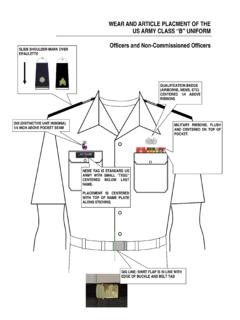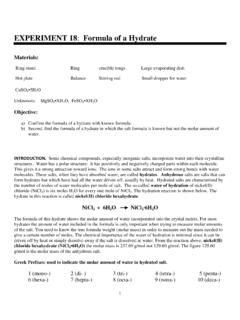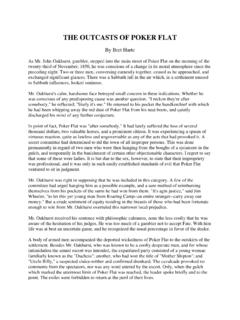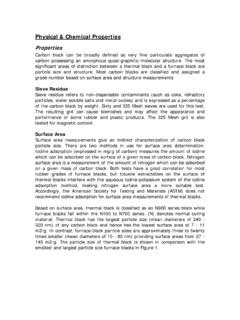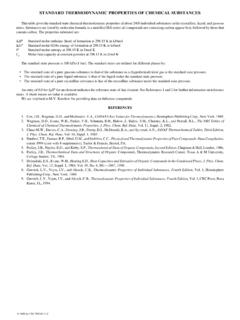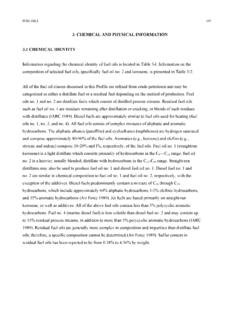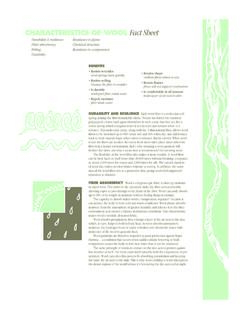Transcription of EXPERIMENT 3: Identification of a Substance by Physical ...
1 1 EXPERIMENT 3: Identification of a Substance by Physical properties Materials: Hot plate Digital balance Capillary tubes (3) Thermometer Beakers (250 mL) Watch glass Graduated Cylinder (10 mL) Mel-Temp apparatus Test tubes (2 small, and 1 large) Test tube rack (1) Objective: To learn the use of Physical properties such as solubility, density, boiling point, and melting point in identifying liquids and solids substances.
2 INTRODUCTION Every Substance has a unique set of properties that allow us to differentiate one from another. These properties can be classified as either Physical properties or chemical properties . Physical properties are those that can be determined or measured without changing the composition or identity of the Substance . These properties include color, odor, taste, density, melting point, boiling point, conductivity, and hardness. Chemical properties tell us how a Substance interacts with other substances. Such properties include reaction with oxygen (oxidation), chlorine, metals, etc. Determination of chemical properties results in the change of the identity of the Substance .
3 Some properties , such as solubility, melting point, boiling point, and density are independent of the amount of Substance being examined. These properties are known as intensive properties and are used to identify a Substance . Extensive properties such as mass and volume depend on the amount of Substance present and are not useful in the Identification of a Substance . In this EXPERIMENT , we will use three properties to identify a liquid Substance - solubility, density and boiling point. Solubility The solubility of a solute (a dissolved Substance ) in a solvent (the dissolving medium) is the most important chemical principle underlying three major techniques you will study in organic chemistry laboratory - crystallization, extraction, and chromatography The solubility of a Substance is usually defined as the mass (g) of that Substance which will dissolve in a fixed amount of solvent (usually 100g of a liquid) at a given temperature.
4 Depending on its molecular structure, a solute will have different solubilities in different solvents. For example, sodium chloride (table salt) is an ionic compound. It is soluble in polar solvents such as water, but insoluble in non-polar solvents such as cyclohexane or toluene. Sodium chloride may only be slightly soluble in a solvent that has both polar and non-polar properties . Such a solvent is a weakly polar solvent. In this EXPERIMENT , we will use three solvents to compare solubilities: water (polar), cyclohexane (non-polar), and ethanol (weakly polar). The solubilities will be recorded as soluble (completely dissolved), slightly soluble (partially dissolved), or insoluble (not dissolved at all).
5 We will use the following terms: S for soluble, I for insoluble, and SLS or SS for slightly soluble. 2 Part of this EXPERIMENT will involve determining whether an organic solid compound is soluble or insoluble in a given solvent. You should keep in mind that this is actually an over simplification since some solids may be partially soluble in a given solvent. If an organic liquid compound dissolves in a solvent, it is sometimes more appropriate to say that the compound and the solvent are miscible (mix homogeneously in all proportions). Likewise, if an organic liquid compound is insoluble in the solvent, then they are immiscible (do not mix and forms two liquid phases).
6 The concentration of a solution can be derived by expressing solubility in quantitative terms. An example is the solubility of table salt in water which is g/100 cc of water. Density Density = mass / volume or D = m / v Density is defined as mass per unit volume. Mass is usually measured in g and volume in mL or cm3. Since two substances rarely have the same density, it is a useful Physical property in order to identify unknown substances. Heavy elements such as lead and gold have high densities while elements that are light in weight typically have low densities. For most substances, the variation in density with temperature is negligible.
7 It is usually expressed at 20 C, which is considered to be room temperature. The density of water from 0 to 30 C, is tabulated in Table 1. The density of a liquid is usually reported in units of grams per milliliter (g/mL). The density of a solid is reported in units of grams per cubic centimeter (g/cm3). Because 1 mL is equivalent to 1 cm3, these units are interchangeable. The density of water is g/cm3 at 4 C and is slightly less at room temperature ( g/cm3 at 25 C). Boiling point Boiling point is defined as the temperature at which the vapor pressure of a liquid becomes equal to the pressure at the surface of the liquid.
8 The boiling point of a liquid can change if the pressure at the surface of the changes. Since pure substances have a distinct boiling points, boiling points are sometimes used to determine the purity of substances. A liquid gets converted in to its gaseous state when the temperature of the liquid reaches its boiling point. This is indicated by bubbles of its vapor rising in all parts of the liquid. This is the temperature at which the pressure of the saturated vapor of the liquid is equal to the pressure of the atmosphere under which the liquid boils. Normally, boiling points are determined at standard pressure: 760 mm Hg (torr) or 1 atm.
9 The boiling point of a liquid is sensitive to changes in atmospheric pressure and varies directly with it. At approximately normal pressure, the boiling point of a liquid will drop about C for every 10-mm Hg drop in pressure. At much lower pressures, close to 10 mmHg, the temperature will drop about 10 C when the pressure is halved. 3 Melting point The melting point of a solid is defined as the temperature at which the liquid and solid phases are in equilibrium at a given pressure. At this temperature, a solid is converted to liquid. This is an important property of solids. The melting point of solids, like the boiling point of liquids, is often used for the Identification of substances.
10 The normal melting point of a solid is defined as the temperature at which the solid and liquid phases of a solid are in equilibrium at a total pressure of 1atm. Pure crystalline substances have clear, sharply defined melting points. During the melting process, all of the energy added to a Substance is consumed as heat of fusion, and the temperature remains constant. A pure Substance melts at a precisely defined temperature, characteristic of every crystalline Substance and dependent only on pressure. In contrast to the volume change that accompanies the vaporization of a liquid, the change in volume that takes place upon the melting of a solid is very small.
